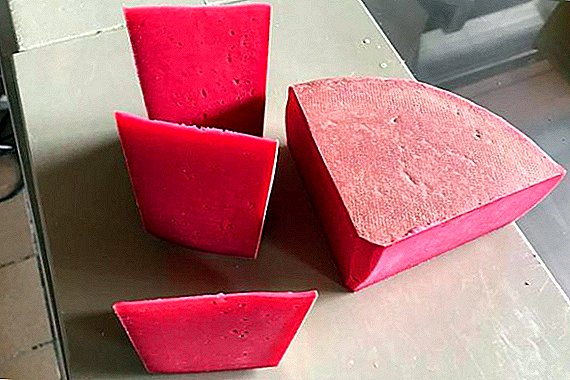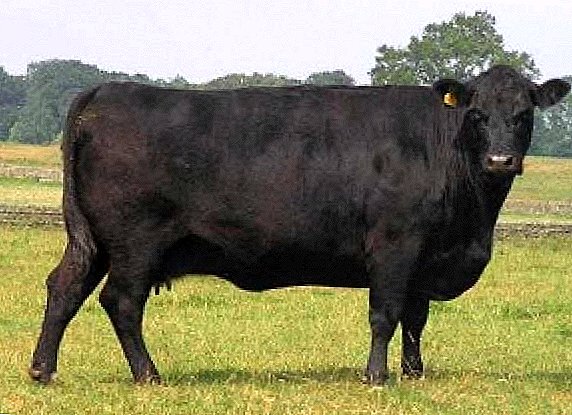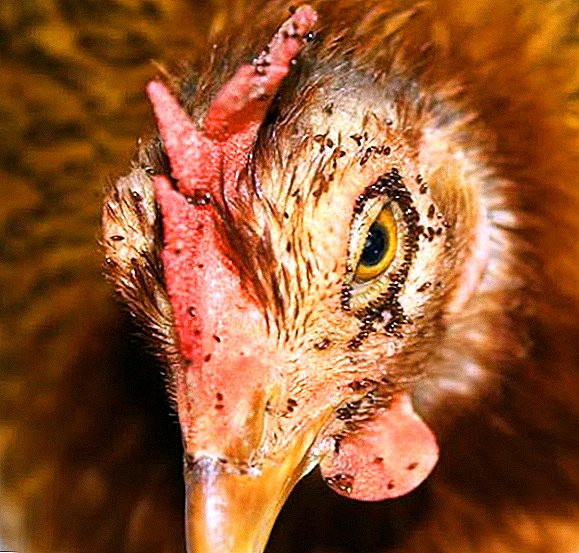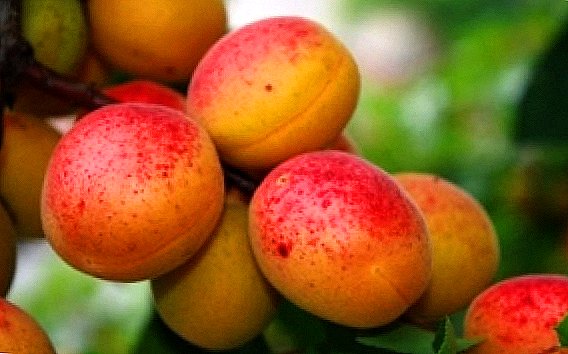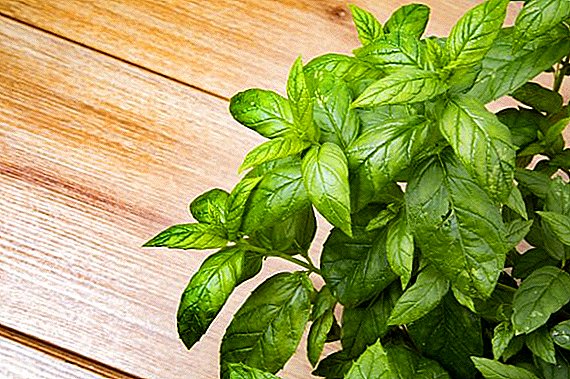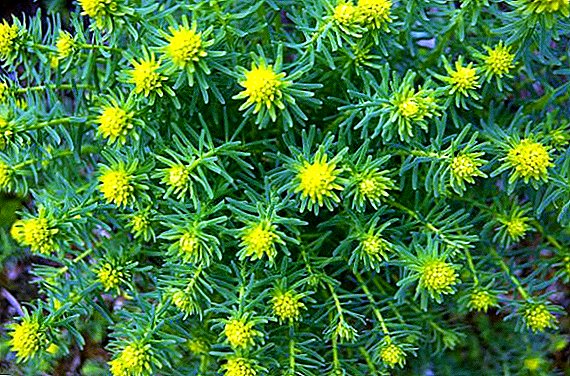 Each gardener is looking for a plant for his bed that does not require special care and tolerates any weather conditions. In addition, it is important that the plant does not need to be sown every year or repotted.
Each gardener is looking for a plant for his bed that does not require special care and tolerates any weather conditions. In addition, it is important that the plant does not need to be sown every year or repotted.
So perennial is Euphorbia cypress.
Botanical description
Spurge cypress (from the Latin Euphórbia cyparissias) is a succulent perennial herb from the genus Euphorbia (Euphorbia), family Euphorbia (Euphorbiaceae). Name options: spurge, milk jail.
Height is 15-30 cm. Color - gray-green. Perennial is smooth or slightly fluffy. The root has a branched cylinder shape. Stems 15-24 cm tall straight with branches. Dense leaves, needles are alternate, opposite, oblong-lanceolate, linear-lanceolate.  The perianth is absent from the flowers, they are grouped into an umbrella-shaped inflorescence, which consists of several parts. Goblet yellow-green coating is around the flowers. They are feminine and masculine. If the male type has one stamen, then the female type has a pistil and a three-star ovary. Milkweed flowers have a strong aroma.
The perianth is absent from the flowers, they are grouped into an umbrella-shaped inflorescence, which consists of several parts. Goblet yellow-green coating is around the flowers. They are feminine and masculine. If the male type has one stamen, then the female type has a pistil and a three-star ovary. Milkweed flowers have a strong aroma.
In late spring, hemispheric inflorescences of olive-yellow or lilac shade appear on the upper part of the stem.
The fruit is a truncated ovoid tripleshorn, whose length is 3 mm, characterized by a small tuberosity.
Demanding on soil and place
Garden perennial spurge planted in black soil, rubble or stony soil. If the grass is planted on an alpine hill, it is recommended to make a soil substrate, which includes sand, peat or compost. Such care will be complete and balanced.
Although spurge is unpretentious, it is still better to avoid planting in shady areas, since it will become thin, high and will cease to perform its decorative function. Perennial is better acclimatized in sunny areas. 
Did you know? The chemical composition of milkweed includes rubber and resin.The ancestors of euphorbia grew in lack of moisture, so now this plant perceives dry weather better than increased humidity. It should be taken into account that this perennial is rather aggressive. therefore worth limiting it in space, as there are known cases of harm to neighboring plants.
Planting and reproduction of milkweed
If a suitable place for a plant on a plot of land has already been chosen, then it is worthwhile to familiarize yourself with how exactly the spurges are planted and what needs to be prepared for this.
Seeds
Planting milkweed cypress can be with the help of seeds. This is the easiest breeding option. Analyzed herbaceous plant rises in the spring. For this you need to plant seeds in the open ground in the fall. Special care is not needed.
For beauty and benefit, they also grow Echinacea, Badan, lemon balm, roses, stonecrop, lovage, lily of the valley, St. John's wort, catnip, ginseng.These rules are followed in order for the plant to take root before the onset of cold weather. If you are sowing seeds that you have collected yourself, then it is better to do this at the beginning of autumn. So they will ascend better. Those seeds that were stored in a warm place may go worse. Therefore, you should worry about favorable storage conditions.

Vegetative methods
This type of succulent breeding is performed. by dividing a bush or root into parts. In the spring or autumn you need to dig up the uterine part of the plant, divide it into several parts and plant on another piece of land.
Vegetative method includes and grafting It is necessary to cut the cuttings from the existing shoots, rinse them with water, as the juice is released, and sprinkle with activated carbon powder in the place of the cut.
Next, you should plant cuttings of milkweed cypress in the mixture, which consists of chernozem, sand and charcoal. So the cuttings will germinate. The minimum care is to maintain the wet state of the cuttings. Within a month, they form roots that will be ready for planting in open soil.
This method is less used, because the previous one stably shows itself positively during planting and reproduction.
How to care for a plant?
Since spurge is a perennial plant, it must be taken care of not only during flowering or planting, but also at other times of the year. Simple tips will help maintain plant life all year round.
Do I need to water?
Spurge is known for its drought tolerance. Therefore, it is not necessary to water it, only in the first time after it is planted or if you want to increase its decorative properties. Grass can live without water, but it will not be so lush and colorful.
From the vast family of succulents in our latitudes in the front gardens grow stonecrop, Rhodiola rosea, young.
Top dressing
It is recommended to add humus or compost to the ground in small quantities. Thus, you can provide the plant with the necessary reserve of food for several years. But if you do not have the opportunity to feed euphorbia, you can do without it.
Agronomists advise to mulch the soil with the help of humus or sawdust during the preparation of perennial for winter. This advice is relevant if the seeds of the plant were sown in the fall.  In case humus was added during planting, the succulent does not need fertilizer for a long period. You can bring in the land of mineral resources with a frequency of 1 time per season, often not worth it.
In case humus was added during planting, the succulent does not need fertilizer for a long period. You can bring in the land of mineral resources with a frequency of 1 time per season, often not worth it.
Pruning
Euphórbia cyparissias needs pruning to look neat and expressive. Better to do it at the end of flowering. This procedure will give him a neat look and will contribute to the next bloom. It is possible and not to prune off the jail, but then it will look like a weed.
Important! When trimming perennials, you must take precautions, namely, wear gloves, as the plant produces a toxic liquid.
Transfer
The herb should not be replanted often, because it can damage the organs of its vegetation. Florists recommend perennial transplant no more than 1 time in 5 years.  Euphorbia cypress - quite aggressive plant, which with the growth occupies other territories. Such unwanted breeding must be controlled and new seedlings removed in a timely manner. During planting is to limit the plant slate, wooden structures.
Euphorbia cypress - quite aggressive plant, which with the growth occupies other territories. Such unwanted breeding must be controlled and new seedlings removed in a timely manner. During planting is to limit the plant slate, wooden structures.
Wintering
The analyzed plant has high frost resistance, therefore it can overwinter without shelter. It is only necessary to cut dry and broken shoots for the winter. As an exception, sometimes in severe and snowless winters large bushes need warming with spruce branches.
Did you know? In ancient Egypt, the juice of euphorbia cypress was used in the treatment of ulcers, insect bites, and animals.
Useful properties of cypress euphorbia
Cypress spurge has many useful properties:
- Water tincture Cypress Milkweed has medicinal properties: it is characterized by an antibacterial effect.
- It has a laxative, diuretic, diaphoretic, anesthetic anti-inflammatory, choleretic action.
- Honey obtained from perennial, is used in the treatment of sclerosis, anemia. It cleans the blood vessels, does not allow the development of cardiovascular diseases.
- Juice used for diarrhea, hemorrhoids, diseases of the stomach, used against warts, depriving scabies.
- TeaInfused with leaves, they drink in cases of treatment of kidney, cystitis, dysentery.
- From gout make baths from boiled leaves.
- Infusion chirya and fungus are treated.
Important! Do not use perennial as a medicine without first consulting a doctor. It is necessary to take into account the poisonous, and not only the therapeutic properties of euphorbia cypress.As we have seen, euphorbia cypress is suitable for both beginners and experienced gardeners. It is characterized by resistance to frost and drought, minimal maintenance costs, and an easy landing algorithm. Used for decorative purposes, has medicinal properties that can be checked after consulting a doctor.


